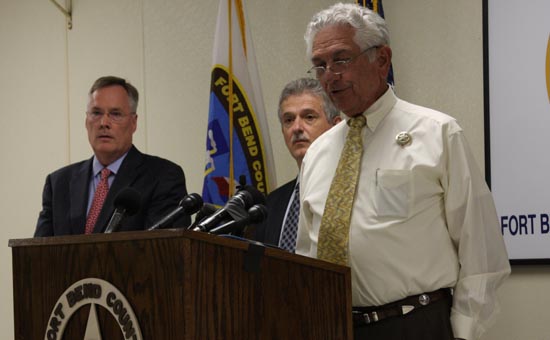
The Fort Bend County Sheriff’s Office, U.S. Attorney’s Office and the Drug Enforcement Agency perpetuated misconceptions about the typical anabolic steroid user during a May 27, 2009 press conference announcing a major steroid bust involving personal trainers, their clients and bodybuilders in Fort Bend County Texas. Steroids users were compared to traditional recreational drug abusers; officials suggested that steroid users posed the same risk/dangers to society as cocaine, heroin and methamphetamine users.
A large-scale, scientific survey of almost 2,000 non-medical anabolic steroid users published in 2007 has invalidated these assumptions. Contrary to popular assumptions about steroids users held by officials at the Fort Bend County press conference, the typical anabolic steroid user is a highly-functioning, highly-educated, health-focused, goal-oriented, white collar professional earning an above-average income who attempts to use anabolic steroids responsibly in order to improve muscle strength, body composition and physical appearance (“A league of their own: demographics, motivations and patterns of use of 1,955 male adult non-medical anabolic steroid users in the United States,” October 11, 2007).
The majority of respondents did not initiate AAS use during adolescence and their NMAAS use was not motivated by athletics. The typical user was a Caucasian, highly-educated, gainfully employed professional approximately 30 years of age, who was earning an above-average income, was not active in organized sports, and whose use was motivated by increases in skeletal muscle mass, strength, and physical attractiveness. These findings question commonly held views of the typical NMAAS user and the associated underlying motivations.
The troubling ignorance regarding the demographics, motivations and patterns of use by steroid users highlights the unfortunate underpinnings of current flawed steroid law enforcement policy. Law enforcement officials seemed more interested in promoting self-serving steroid propaganda than accurate steroid information in their comments to the press.
Houston DEA Special Agent Zoran Yankovich, when not warning reporters about steroid-induced heart bursting, described the arrested personal trainers, their clients and bodybuilders as no different that drug dealers selling cocaine and heroin. It is incredible that the DEA would even claim to give steroid use in Fort Bend County the same attention that it would give the Mexican drug-cartel’s trafficking of cocaine through the county (Authorities round up drug suspects, May 27).
“Those arrests today are no different than traditional drug dealers peddling their poison -methamphetamines and cocaine and heroin – on the street corner.”
Acting United States Attorney Tim Johnson, in all seriousness, expected the public to believe that the Houston-area communities are safer now that individuals using steroids to improve their physical appearance have been arrested (“Deep In Cocaine Country, Fort Bend’s Biggest-ever Drug Bust Involves Anabolic Steroids,” May 27).
The bottom line is, Richmond, Rosenberg, Sugar Land and all of Fort Bend County is a safer place today, said U.S. Attorney Tim Johnson
White collar professionals, emergency first responders, fitness professionals and recreational bodybuilders who use anabolic steroids to increase muscle size, muscle strength and physical appearance are apparently a dangerous threat to society. Houston firefighter Brad Ascenzi (who was awarded the Medal of Valor); Chase Bank Manager Jeremy Canton; St. Catherine’s Hospital radiology supervisor Victor Broussard; successful businessman and gym owner Lee Thompson; and other gainfully employed individuals were among those arrested in the Fort Bend County steroid bust. It is unclear how these arrests make the community safer (“New details in massive Ft. Bend Co. drug bust,” May 29).
Fort Bend County Sheriff Milton Wright blindly asserted that steroids caused the break down of families due to the adverse psychological effects of anabolic steroids (“Bodybuilders, Personal Trainers and Gym Owner Arrested in Texas Steroid Bust,” May 27).
“Steroids. A lot of people don’t think there’s much danger in steroids, but there’s a lot of broken family, broken homes. People are hurt by the illegal use of steroids that we never hear about.”
Fort Bend County Sheriff Lt. Glen Dening asserted that, even in the absence of any evidence that steroids were being used by high school students during the course of the 2-1/2 year investigation, high school students would have eventually purchased steroids from the arrested suspects (Fort Bend holds suspects in alleged steroid ring, May 28).
They (suspects) work out at all the local gyms in Fort Bend County, so, of course, the high school students have access to those gyms. So, inevitably, it’s going to happen. They’d end up customers of these steroid dealers.”
Both anecdotal observations and scientific surveys of users clearly indicate that anabolic steroid users are NOT comparable to other drug abusers. The typical steroid use is likely to be a highly-educated, high-functioning, successful, professional who uses steroids responsible in goal-directed behaviors aimed at self-improvement. However, steroid propaganda is utilized to demonize steroid users thereby justifying flawed steroid law enforcement policy that treats steroids users like recreational drug abusers.

About the author
Millard writes about anabolic steroids and performance enhancing drugs and their use and impact in sport and society. He discusses the medical and non-medical uses of anabolic-androgenic steroids while advocating a harm reduction approach to steroid education.

No replies yet
Loading new replies...
Join the full discussion at the MESO-Rx →